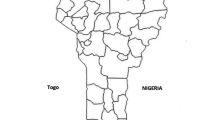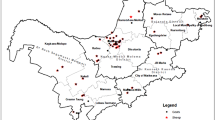Abstract
This study aimed to describe the transmission of T. gondii in naturally infected goats in the semiarid region of northeastern Brazil, through evaluating the serological status of these animals from one to 12 months of age. Seven goat farms were selected. During the first visit, an epidemiological questionnaire was applied. Blood samples were collected from pregnant goats and from their female offspring every month, to monitor them for anti-T. gondii antibodies, using the indirect fluorescence antibody test (IFAT). Out of 66 pregnant goats evaluated, 47% (31/66) (95% CI: 34.6% - 59.7%) were positive and out of 93 female offspring, 61.3% (57/93) (95% CI: 52.4% - 69.2%) were positive, in at least one month during the evaluation period. Among the positive female offspring, 43.3% (27/57) (95% CI: 39.7% - 56.9%) presented environmental infection and 56.7% (30/57) (95% CI: 43.4% - 66.3 %) probably had only colostral antibodies or vertical transmission. It was observed that 92,6% (25/27) from environmental infections occurred until reproductive age (six months) (p<0.0001). It was also noted that there is a correlation between the titration of mothers and offspring, until four months of age (p<0.0001). Large fluctuations in the presence of antibodies were observed among the animals over the months monitored. It can be concluded that the prevalence of anti-T. gondii antibodies within the herds was greater than what has been expressed in specific prevalence studies and that most goat become infected up to the six months of life in the studied area.


Similar content being viewed by others
Data availability
All data generated or analyzed during this study are included in this published article.
References
Abu-Dalbouh MA, Ababneh MM, Giadinis ND, Lafi S (2012) Ovine and caprine toxoplasmosis (Toxoplasma gondii) in aborted animals in Jordanian goat and sheep flocks. Trop Anim Health Prod 44:49–54
Bawm SB, Maung WY, Win MY, Thu MJ, Chel HM, Khaing TA, Wai SS, Htun LL, Myaing TT, Tiwananthagorn S, Igarashi M, Katakura K (2016) Serological Survey and factors associated with Toxoplasma gondii infections in domestic goat in Myanmar. Scientifica 2016:1–4
Belluco S, Mancin M, Conficoni D, Simonato G, Pietrobelli M, Ricci A (2016) Investigating the Determinants of Toxoplasma gondii Prevalence in Meat: A Systematic Review and Meta-Regression. PLoS ONE 11(4):e0153856. https://doi.org/10.1371/journal.pone.0153856
Blewett DA (1983) The epidemiology of ovine toxoplasmosis. I The interpretation of data for the prevalence of antibody im sheep and other host species. Brit Vet J 139:537–545
Buxton D (1998) Protozoan infections (Toxoplasma gondii, Neospora caninum and Sarcocystis spp.) in sheep and goats: recent advances. BMC Vet Res 29(3-4):289–310
Caldeira FHB, Ubiali DG, Godoy I, Dutra D, Aguiar DM, ALT M, Riet-Correa F, Colodel EM, Pescador CA (2011) Outbreak of caprine abortion by Toxoplasma gondii in Midwest Brazil. Pesq Vet Bras 31(11):933–937
Charleston WAG (1994) Toxoplasma and other protozoan infections of economic importance in New Zealand. N Z J Zool 21:67-81
Christley RM, Morgan KL, Parkin TDH, French NP (2003) Factors related to the risk of neonatal mortality, birth-weight and serum immunoglobulin concentration in lambs un the UK. Prev Vet Med 57(4):209–226
Costa DGC, Marvulo MFV, Silva JSA, Santana SC, Magalhães FJR, Lima Filho CDF, Ribeiro VO, Alves LC, Mota RA, Dubey JP, Silva JCR (2012) Seroprevalence of Toxoplasma gondii in domestic and wild animals from the Fernando de Noronha, Brazil. J Parasitol 98:679–680
Djoki’c V, Klun I, Musella V, Rinaldi L, Cringoli G, Sotiraki S, Djurkovic-Djakovic O (2014) Spatial epidemiology of Toxoplasma gondii infections in goats in Serbia. Geospat Health 8(2):479–488
Dong H, Su R, Lu Y, Wang M, Liu J, Jian F, Yang Y (2018) Prevalence, risk factors, and genotypes of Toxoplasma gondii in food animals and humans (2000-2017) from China. Front Microbiol 9:2108
Dubey J P (2021) Diagnosis. In: Toxoplasmosis of animals and humans. 3° ed. Boca Raton: CRC Press.1.7: 52-71
Dubey JP, Murata FHA, Cerqueira-Cézar CK, Kwok OCH (2020) Public health and economic importance of Toxoplasma gondii infections in goats: The last decade. Res Vet Sci 132:292–307
Feitosa TF, Costa FTR, Ferreira LC, Silva SS, Santos A, Silva WI, Brasil AWL, Vilela VLR (2021) High rate of feline immunodeficiency virus infection in cats in the Brazilian semiarid region: Occurrence, associated factors and coinfection with Toxoplasma gondii and feline leukemia virus. Comp Immunol Microbiol Infect Dis 79:101718. https://doi.org/10.1016/j.cimid.2021.101718
Ferreira Neto JM, Ferreira FP, Miura AC, Almeida JC, Martins FDC, Souza M, Bronkhorst DE, Romanelli PR, Pasquali AKS, Santos HLEPL, Benitez AN, Caldart ET, Zanella LF, Freire RL, Navarro IT (2018) An outbreak of caprine toxoplasmosis – invetiation and case report. Ciênc Rural 48(5):1–5
Fonseca JF, Cruz RC, Pinto PHN, Facó O (2011) Manual of synchronization and estrus induction and ovulation in sheep and goats. Sobral-CE: Embrapa Goats and Sheep 103:1–59
Francisco PRM, Santos D (2017) Climatology of the State of Paraíba. EDUFCG, Campina Grande
Garcia JL, Navarro IT, Ogawa L, Oliveira RC (1999) Seroepidemiology of toxoplasmosis in cats and dogs from rural properties in the municipality of Jaguapitã, state of Paraná. Brazil. Rural Sci 29(1):99–104
Garcia G, Sotomaior C, Nascimento AJ, Navarro IT, Soccol VT (2012) Toxoplasma gondii in goats from Curitiba, Paraná, Brazil: risks factors and epidemiology. Rev Bras Parasitol Vet, 21 (1): 42–47
Gilbert RP, Gaskins CT, Hillers JK, Parker CF, Mcguire TC (1988) Genetic and environmental factores affecting immunoglobulin G1 concentrations in ewe colostrum and lamb serum. J An Sci 66(4):855–863
Hosmer DW and Lemeshow S (2000) Applied logistic regression. 2nd Edition, John Wiley & Sons, Inc., New York. doi:10.1002/0471722146
Instituto Nacional de Meteorologia – INMET (2010) Normais climatológicas do Brasil 1981-2010. http://www.inmet.gov.br/portal/index.php?r=clima/normaisClimatologicas Accessed 03 December 2020
Ishwar AK (1995) Pregnancy diagnosis in sheep and goats: a review. Small Rum Res 17:37–44
Kim PC, Melo RP, Almeida JC, Silva JG, Ribeiro-Andrade M, Porto WJ, Pinheiro Júnior JW, Mota RA (2019) Serological response to Neospora caninum infection in goats and agreement between three diagnostic techniques to detect caprine neosporosis. Pesq Vet Bras 39(1):25–31. https://doi.org/10.1590/1678-5150-PVB-5989
Lúcio EC, Clemente SMS, Pimentel JL, Oliveira JMB, Silva Júnior JL, Albuquerque PPF, Mota RA, Pinheiro Junior JW (2016) Epidemiological analysis of Toxoplasma gondii infection in goats in the state of Pernambuco. Brazil. Rev Bras Med Vet. 38(1):13–18
Male D, Brostoff J, Roth DB, Rostt IM (2014) Imunologia, 8a ed., Rio de Janeiro: Elsevier
Mcguire TC, Regnier J, Kellom T, Gates N (1983) Failure in passive transfer of immunoglobulin G1 to lambs: measurement of immunoglobulin G1 in ewe colostrums. Am J Vet Res 44(6):1064–1067
Medeiros AD, Andrade MMC, Vitor RWA, Andrade-Neto VF (2014) Occurrence of anti-Toxoplasma gondii antibodies in meat and dairy goat herds in Rio Grande do Norte. Brazil. Rev Bras Parasitol Vet 23(4):481–487
Mesquita EP, Oliveira JMB, Silva GM, Torres SM, Oliveira AAF, Silva Júnior VA, Mota RA, Amorim MJAAL (2019) Immunodetection of Toxoplasma gondii in placental tissue of naturally infected goats. Arq Bras Med Vet Zootec 71:86–92
Moeller RB (2011) Causes of caprine abortion: diagnostic assessment of 211 cases (1991-1998). J Vet Diagn Invest 13:265–270
Navarro JA, Ortega N, Buendia AJ, Martínez CM, Sánchez J, Gallego MC, Caro MR, Salinas J (2009) Diagnosis of placental pathogens in small ruminants by immunohistochemistry and PCR on paraffin-embedded samples. Vet Rec 165:175–178
Nunes FVA, Vaez JR, Pinheiro RR, Cavalcante ACR, Vitor RWA, Ahid SMM (2013) Seroprevalence and factors associated with Toxoplasma gondii infection in goats from rural properties in the municipality of Mossoró. RN. Pesq Vet Bras 33(5):565–570
Pereira MF, Peixoto RM, Langoni H, Greca Junior H, Azevedo SS, Porto WJN, Medeiros ES, Mota RA (2012) Risk factors associated with Toxoplasma gondii infection in sheep and goats in the state of Pernambuco. Pesq Vet Bras 32:140–146
Pinheiro RR, Gouveia AMG, Alves FSF, Haddad JPA (2000) Aspectos epidemioógicos da caprinocultura cearense. Arq Bras Med Vet Zootec 52(5):534–543
Santos KR, Lemos JF, Lopes CD, Sousa RA, Oliveira MRA, Luz CSM, Sousa Júnior SC (2018) Occurrence and risk factors for Toxoplasma gondii infection in goats from micro-regions of the state of Piauí. Semina Ci Agr 39:2457–2464
Shaapan RM, El-Nawawi FA, Tawfik MAA (2008) Sensitivity and specificity of various serological tests for the detection of Toxoplasma gondii infection in naturally infected sheep. Vet Parasitol 153(3-4):359–362
Tizar IR (2019) Imunologia Veterinária, 10ª ed., Rio de Janeiro: Elsevier
Unzaga JM, Moréa G, Bacigalupe D, Rambeaud M, Pardini L, Dellarupe A, De Felice L, Gos ML, Venturini MC (2014) Toxoplasma gondii and Neospora caninum infections in goat abortions from Argentina. Parasitol Int 63: 865-867
Valencio BA, Bezerra RA, Vilela VLR, Feitosa TF, Amaku M, Azevedo SS, Gennari SM (2020) Longitudinal study of Toxoplasma gondii antibodies in female lambs from Paraíba State, Brazil. Small Rum Res 188:106–125
Wanderley FS, Porto WJ, Câmara DR, Da Cruz NL, Feitosa BC, Freire RL, De Moraes EP, Mota RA (2013) Experimental vaginal infection of goats with semen contaminated with the “CPG” strain of Toxoplasma gondii. J Parasitol 99:610–613
Wang ZD, Liu HH, Ma ZX, Ma HY, Li ZY, Yang ZB, Zhu XQ, Xu B, Wei F, Liu Q (2017) Toxoplasma gondii infection in immunocompromised patients: a systematic review and Meta-Analysis. Front. Microbiol 8 (389):1-12
Zar JH (1999) Biostatistical analysis, fourth ed, Upper Saddle River: Prentice Hall
Acknowledgements
The authors would like to thank FAPESQ (Foundation for Research Support of the State of Paraíba) for the scholarship granted to LNS and CNPq for the scholarship granted to RAM and VLRV.
Funding
This study received no funding.
Author information
Authors and Affiliations
Contributions
LNS, VLRV and TFF designed the experiments; LNS, SPB, SSS, RFS, WFS and RAM performed the experiments; LNS, VLRV, TFF and MA analyzed the data; LNS, VLRV and TFF wrote and edited the manuscript.
Corresponding author
Ethics declarations
Declaration of competing interest
The authors declare that they have no known competing financial interests or personal relationships that could have appeared to influence the work reported in this paper.
Ethical statement
The experiments conducted in this study were approved and performed according to the recommendations of the Ethics Committee on the Use of Animals of the Federal Institute of Paraíba, Campus Sousa (CEUA - IFPB), under protocol protocol 23000.001402.2018-64.
Consent to participate
Authors have permission to participate.
Consent for publication
Authors have permission for publication.
Additional information
Publisher’s note
Springer Nature remains neutral with regard to jurisdictional claims in published maps and institutional affiliations.
Rights and permissions
About this article
Cite this article
Sousa, L.N., Batista, S.P., Silva, S.S. et al. Dynamics of natural infection by Toxoplasma gondii in goat herds in the semiarid region of northeastern Brazil: transitional antibody observation. Vet Res Commun 46, 507–515 (2022). https://doi.org/10.1007/s11259-021-09878-0
Received:
Accepted:
Published:
Issue Date:
DOI: https://doi.org/10.1007/s11259-021-09878-0




